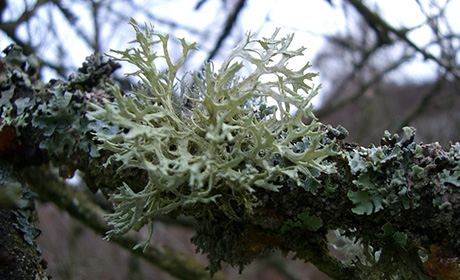Scientists Discover New Source of Greenhouse Gases
8 July 2015
Mosses, lichens and cyanobacteria produce large amounts of nitrous oxide

Photo: Katharina Lenhart
Seemingly nondescript organisms are having a surprisingly major impact on the environment: lichens, mosses, and cyanobacteria are releasing large amounts of the greenhouse gas nitrous oxide (N2O) and small amounts of methane (CH4) into the atmosphere. This vegetative covering – known as a cryptogamic covers, which also include other microorganisms – is responsible for four to nine percent of naturally occurring N2O. Comprehensive laboratory experiments by researchers at Heidelberg University, the University of Gießen and the Max-Planck Institute for Chemistry in Mainz arrived at these astonishing findings. At the same time, their work revealed that the amount of nitrous oxide emitted increases as the temperature rises. “Our discovery has even greater significance in light of global warming,“ says Heidelberg geochemist Prof. Dr. Frank Keppler. The results of the research were published in the journal “Global Change Biology”.

The researchers started by investigating whether cryptogam covers emitted N2O and CH4 at all and how climatic conditions might affect the emission values. They studied 68 samples of various lichens, mosses and cyanobacteria from different climatic regions. the scientists recorded the greenhouse gas emissions of the organisms at different temperatures, water contents, light conditions and nitrogen fertilisation to determine the impact of environmental conditions on the release of the gases.
The results of the research prove that methane emissions from cryptogamic covers are negligible on a global scale. The experts do agree, however, that the high emission rates of nitrous oxide are remarkable – their high greenhouse potential makes them many times more damaging than CO2. The team demonstrated that N2O and CH4 emissions rise dramatically starting at 20 degrees Celsius. The scientists therefore hypothesise that the methane and nitrous oxide emissions from lichens, mosses and cyanobacteria could increase during the course of global warming. According to Prof. Keppler, this would be of greater significance especially in temperate-zone forests, where cryptogamic covers are a main source of nitrous oxide emissions.
This research builds on the results of earlier studies in Mainz, in which scientists at the Max Planck Institute for Chemistry discovered that cryptogam layers absorb large amounts of carbon dioxide and nitrogen from the atmosphere. It turns out that lichens, mosses and cyanobacteria absorb about as much carbon dioxide as is emitted annually from burning biomass or fossil fuels. The recently published study was also sparked by the findings of Keppler's team of researchers, who proved that plants and fungi could also produce methane. Up until that time, it was generally assumed that biogenic methane only formed from the fermentation of organic materials in the absence of oxygen.
Dr. Katharina Lenhart of the Institute for Plant Ecology at the University of Gießen and Associate Professor Dr. Bettina Weber of the Max Planck Institute for Chemistry in Mainz collaborated with Prof. Keppler in the research on the nitrous oxide emissions of lichens, mosses and cyanobacteria. In the next phase, the researchers will verify their laboratory results in field studies and also include other organisms in their investigations. Frank Keppler is Heisenberg Professor at the Institute of Earth Sciences at Heidelberg University, where he conducts research in the field of biochemistry. He was previously head of a working group at the MPI in Mainz.
Original publication:
K. Lenhart, B. Weber, W. Elbert, J. Steinkamp, T. Clough, P. Crutzen, U. Pöschl and F. Keppler: Nitrous oxide and methane emissions from cryptogamic covers. Global Change Biology (7 July 2015), doi: 10.1111/gcb.12995

